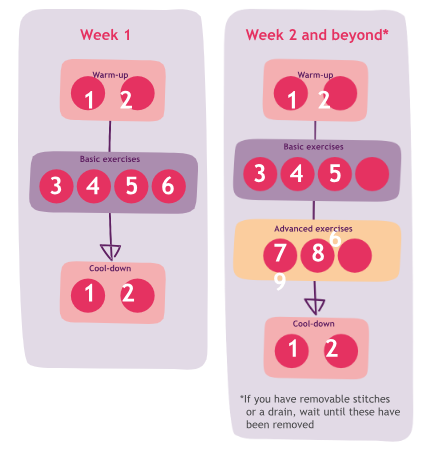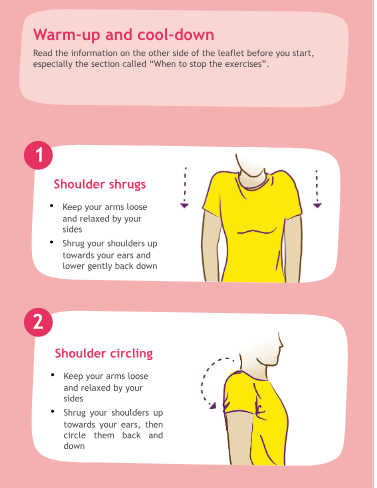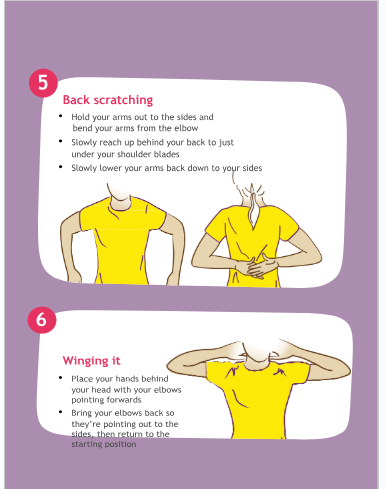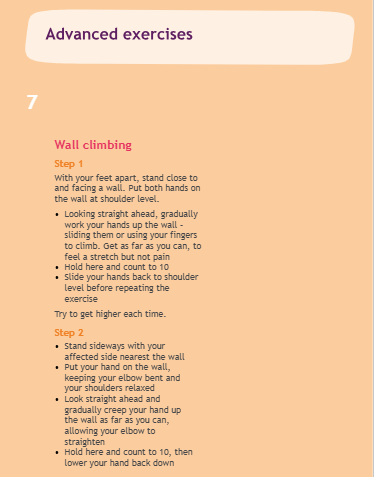Why do I need to do these exercises aŁer my breast surgery?
These exercises can help you regain arm and shoulder movement after surgery and radiotherapy for breast cancer.
Muscles and joints can seize up very quickly if they’re not used, so it’s important to do these exercises as part of your daily routine.
The exercises can also help:
- Improve symptoms that may be caused by tight scars and cording (when a build-up of scar tissue causes blood vessels to become stuck, and you feel as if you have a tight cord running down your affected arm)
- Prevent long-term problems with arm and shoulder movement, posture and stiffness
- Reduce the risk of lymphoedema (swelling of the arm, hand, breast or chest area caused by a build-up of lymph fluid)
If you’re worried about any of these, speak to your breast care nurse or physiotherapist as soon as possible. You should also contact your breast care nurse or physiotherapist as soon as possible if you:
- Had shoulder problems before your surgery
- Develop symptoms of cording after surgery
- Develop a seroma (a collection of fluid that forms under a wound after an operation) after surgery
Who are the exercises suitable for?
The exercises have been developed with the help of breast surgeons, breast care nurses and physiotherapists.
The exercises are suitable for people who have had:
- Breast surgery
- Lymph node removal
- Radiotherapy
If you’ve recently had a breast reconstruction, or any other type of surgery, talk to your surgeon, breast care nurse or physiotherapist before you start any exercises. You should always follow their advice.
When should I start the exercises?
Ideally, you should start these exercises before your surgery. This is so you can begin to build up flexibility and movement in your arm and shoulder before surgery.
You should then aim to begin the exercises again the day after your surgery.
If you feel unable to start the exercises within a couple of days of your surgery, speak to your breast care nurse or physiotherapist.
Don’t worry if you can’t manage to do all the exercises every time. You may find the exercises harder at certain times of your treatment, for example during radiotherapy. Do as much as you feel you can but try to do something every day.
How should the exercises feel?
You should not feel pain when doing the exercises. However, a stretching or pulling sensation is normal. The more you do the exercises, the easier they should become.
Always do the warm-up at the start and the cool-down at the end of each session to help avoid injury and prevent stiffness.
You may be advised to take some pain relief before doing the exercises.
If at any time you become concerned about your range of movement or level of discomfort, speak to your breast care nurse or physiotherapist.
When to stop the exercises
Stop doing the exercises and speak to your surgeon, physiotherapist or breast care nurse as soon as possible if you have:
- A seroma
- A wound infection or problems with your wound healing
- Pain that gets worse during these exercises or continues once you’ve finished them
Start the exercises again when your surgeon, physiotherapist or breast care nurse says it’s safe to do so.
How long should I continue doing the exercises?
If you’ve had surgery
If you’ve had surgery, keep doing the exercises until you’ve got back the range of movement you had before your operation. Continue doing the exercises if you’re going to have radiotherapy, as they will help your shoulder flexibility.
If you’ve had radiotherapy
If you’ve had radiotherapy, it’s a good idea to do the exercises for as long as you’re still feeling tightness and stiffness.
Arm stiffness and weakness can happen after radiotherapy. So continue doing the exercises, or some form of stretching, to maintain your range of movement and use of your arm.
Talk to your breast care nurse or physiotherapist if:
- You’re having difficulty getting your range of movement back
- You’re not sure how long to continue the exercises
- You have concerns about your recovery after surgery
When to do the exercises
- Repeat each exercise 5 times before moving on to the next one
- Try to do the exercises 3 times a day (morning, around midday and evening) for the first 3 months
- After 3 months, and once you have regained usual movement in your arm, continue exercises 1, 3 and 6 once a day to help reduce discomfort and stiffness in the future






ABoUT ThIS BooklET
Exercises aŁer breast cancer surgery was wriGen by Breast Cancer Now’s clinical specialists, and reviewed by healthcare professionals and people affected by breast cancer.
For a full list of the sources we used to research it: Email health-info@breastcancernow.org
You can order or download more copies from
breastcancernow.org/publications
We welcome your feedback on this publication:
health-info@breastcancernow.org
For a large print, Braille or audio CD version:
Email health-info@breastcancernow.org
Medical disclaimer
We make every effort to ensure that our health information is accurate and up to date, but it doesn’t replace the
information and support from professionals in your healthcare team. So far as is permiGed by law, Breast Cancer Now doesn’t accept liability in relation to the use of any information contained in this publication, or third-party information included or referred to in it.
© Breast Cancer Now, April 2024. All rights reserved BCC6, Edition 8, next planned review February 2026
Information you can trust, support you can count on
Whatever breast cancer brings, we’re here for you.
Whether you’re looking for information about breast cancer or want to speak to someone who understands, you can rely on us.
Call 0808 800 6000 to talk things through with our helpline nurses.Visit breastcancernow.org for reliable breast cancer information.
Breast Cancer Now
Fifth Floor, Ibex House, 42–47 Minories, London EC3N 1DY
Breast Cancer Now is a company limited by guarantee registered in England (9347608) and a charity registered in England and Wales (1160558), Scotland (SC045584) and Isle of Man (1200). Registered Office: Fifth Floor, Ibex House, 42–47 Minories, London EC3N 1DY.
Lahore Clinic
- 0324 9780880
- info@drahsanrao.com
- One-stop Clinic (surgical-review,breast ultrasound scan and mammogram, biopsy all in same clinic)
- Shaukat Khanum Hospital Rd, Block R3 Block R 3 Phase 2 Johar Town, Lahore, 54000
Timings
- Assistant : Adeel
- 0324 9780880
- Timings: Tuesday (9 AM to 5 PM) Wednesday (2 PM to 6 PM) Telephonic:(6 PM to 8 PM)
- Copyright © 2024 Dr. Ahsan Rao All rights reserved.


Leave a Reply